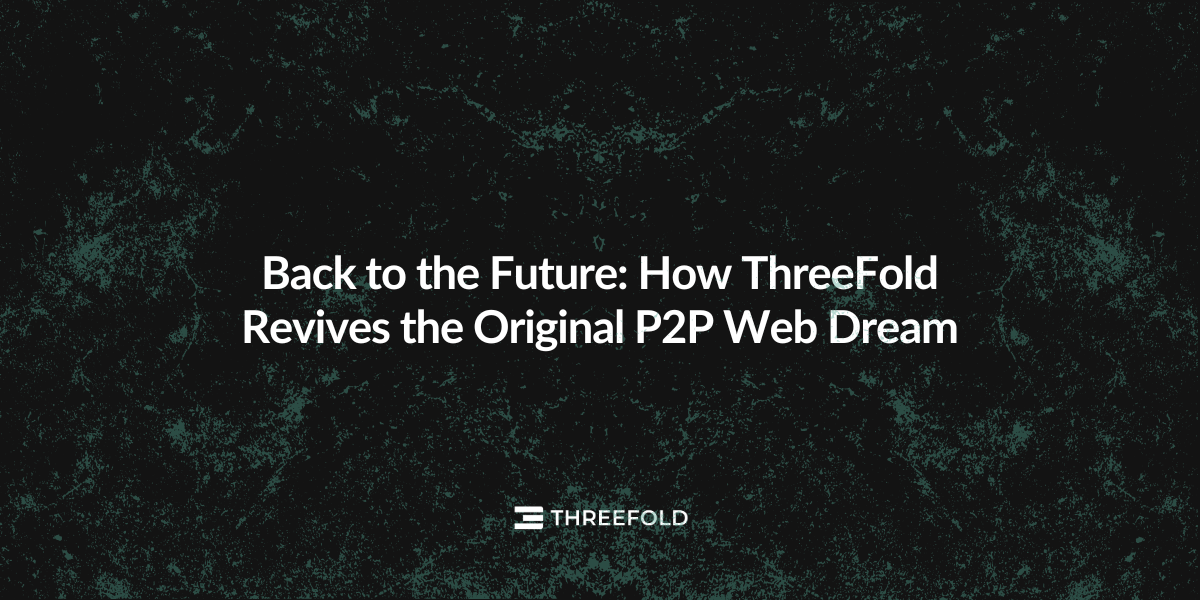Back to the Future: How ThreeFold Revives the Original P2P Web Dream
The internet was meant to empower, not control. ThreeFold is bringing the original peer-to-peer vision back to life, decentralized, open, and owned by all.

In 1989, Tim Berners-Lee envisioned a World Wide Web where people everywhere could create, access, and share knowledge freely. It was a bold and beautiful idea: an open, decentralized platform where humanity could collaborate. Born in the halls of CERN and rooted in academia and scientific generosity, the early web was peer-to-peer in spirit and architecture. But somewhere along the way, we lost the plot.
Today, the internet is dominated by a handful of corporations. It’s centralized, surveilled, and algorithmically manipulated. The original promise of the web, a tool for empowerment, has been rewritten into one of control.
But not everyone has given up on the dream.
🔗A Different Internet Is Possible
We need to restore the internet to its original intent,” says Kristof De Spiegeleer, founder of ThreeFold, in a recent interview at ETHDenver. “It was much more peer-to-peer. People could express whatever they wanted. We were no longer products. That’s what we wanted to bring back.
Kristof’s perspective isn’t nostalgic. At ThreeFold, some of our team has been building internet infrastructure since the early days, when the web still felt like a community garden rather than a corporate mall. In more recent years, we have been radically reimagining the plumbing of the web. And we’re doing it from the ground up.
🔗From CERN to Surveillance Capitalism
To understand what’s at stake, it helps to go back to the beginning.
The first ever website, info.cern.ch, was hosted on a NeXT computer in a physics lab in Switzerland. The web was conceived as a universal publishing system for scientists. It used open standards, interoperable protocols, and encouraged contribution. There were no paywalls. No targeted ads. No “walled gardens.”
All that changed in the 2000s. Google, Facebook, Amazon, and others turned the web into a data-mining operation.
In exchange for “free” services, users unknowingly gave up control over their digital selves. What started as a peer-to-peer web became a hub-and-spoke model, where all roads led through Silicon Valley.
Today, more than 80% of online content is machine-generated. Most of the internet’s infrastructure is owned by a few centralized companies. Many countries don’t even control their own digital backbones.
This was not at all the vision that the early pioneers had.
Tim Berners-Lee:
“The Web is more a social creation than a technical one. I designed it for a social effect—to help people work together—and not as a technical toy.”
Marc Andreessen (Netscape co-founder):
“We thought we were building a publishing platform. Instead, we built the rails for an entirely new economy.”
Jaron Lanier (early VR pioneer and digital ethicist):
“The original idea of the Internet was that it would decentralize power… Now it’s become the opposite.”
🔗Rebuilding the Plumbing
This is where ThreeFold comes in as a decentralized, peer-owned infrastructure layer. Kristof explains it plainly: “We need storage, we need compute, we need GPUs, and we need to connect these things outside of the current web monopolies.”
ThreeFold makes it simple for anyone to contribute to this new internet by running a node. Whether you’re a developer, a farmer, or just someone with an unused computer, you can dedicate a machine to the ThreeFold Grid and become part of a growing decentralized network.
🔗More Than Decentralization
Attempts to “decentralize the web” are nothing new. But most failed because they tried to rebuild the application layer without fixing the foundation. ThreeFold flips that script. It starts with the physical hardware, real nodes owned by real people, and builds upward.
Its architecture is designed for resilience. It doesn’t rely on AWS or Google Cloud. It doesn’t store your data in one vulnerable place. It doesn’t treat you like a product.
And perhaps most importantly, it invites participation. Anyone can build a node, join the network, and help create something bigger than themselves.
🔗Back to the Future?
What ThreeFold is essentially doing is reclamation.
We are reclaiming the peer-to-peer ethos of the early internet.
We are reclaiming the right to compute, connect, and create without gatekeepers.
We are reclaiming agency in a digital world that’s increasingly extractive.
As Kristof puts it: “No is simply not an option. This will be done.”
For those who still believe the internet can be more than a marketplace of user data, for those who remember what it was meant to be, ThreeFold might just be the future we were promised.
And this time, we all get to build it.

